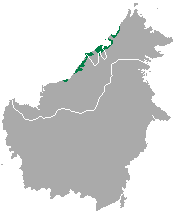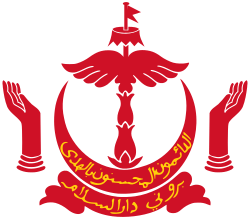Bruneian Malay people
|
A Bruneian Malay bride during her Malam Bebedak pre-wedding ceremony. The Malam Bebedak tradition is unique to the Brunei-Muara District. | |
| Total population | |
|---|---|
| (Est. 330,000[1] (1999 estimate)) | |
| Regions with significant populations | |
|
Sarawak (Lawas, Limbang, Miri) Sabah (Beaufort, Sipitang, Kuala Penyu, Papar) Labuan | |
| Languages | |
| Brunei Malay, Standard Malay and English. | |
| Religion | |
| Predominantly Shafi'i Sunni Muslim | |
| Related ethnic groups | |
| Bruneian people, Malay people |
Bruneian Malays[note 1] (Malay: Orang Melayu Brunei, Jawi: اورڠ ملايو بروني) are a native Malay ethnic group that lives in Brunei, Labuan, west coast Sabah, and the northern parts of Sarawak.[2][3] The Bruneian Malays are different from the larger Ethnic Malays population found in the other parts of the Malay World, namely Peninsular Malaysia and the central and southern areas of Sarawak including neighbouring lands such as Singapore, Indonesia and Southern Thailand especially in language and culture, even though they are ethnically related to each other and follow the teachings of Islam. All Bruneian Malays who are born or domiciled in East Malaysia even for generations before or after the independence of the states of Sabah and Sarawak from the British Empire through the formation of Malaysia in 1963 are also considered Malaysian Malays in the national census and were in the same status like the Malaysian Malays domiciled in Peninsular Malaysian states and the central and southern parts of Sarawak. They are also defined as a part of the Bumiputera racial classification together as a subgroup within the Malaysian Malay ethnic population along with the Kadazan-Dusuns, Ibans, Malaccan Portuguese and the Malaysian Siamese.
Etymology

As per an official statistics, the "Bruneian Malays" term only became official after the 1921 Brunei Ethnic Categories Census, which is different from the 1906 and 1911 census which only mentioned "Barunays" (Brunei's or Bruneian). It is possibly indicated a shift on the self-perception by the Bruneians about their Malay identity.[4]
The earliest recorded documentation by the West about Brunei is by an Italian known as Ludovico di Varthema, who also said the "Bruneian people have fairer skin tone than the peoples he met in Maluku Islands". On his documentation back to 1550;
We arrived at the island of Bornei (Brunei or Borneo), which is distant from the Maluch about two hundred miles, and we found that it was somewhat larger than the aforesaid and much lower. The people are pagans and are men of goodwill. Their colour is whiter than that of the other sort....in this island justice is well administered...[5]
Some historians have suggested that Bruneian Malay have been linked with the Chinese mainland due to its historical sources dependent on Chinese support.
History
Origin
It is widely believed that the Brunei Kingdom was founded in 14th century by the first Sultan, Alak Batatar.[4] However, from the Chinese records, an older Brunei was in existence as far back as 800 years before the founding of Brunei by Sultan Muhammad Shah, the first Sultan of Brunei.[6] Even though some sources stated that the Malays of Brunei came from Yunnan and the Formosa Island (now Taiwan) through to the Philippines and settled on the coastal Borneo before expanding into Sumatra and the other Malay Peninsula as a result of their trading and seafaring way of life, researchers still unable to traced the origin of the old Brunei.[6]
Cultures

Cuisine
As the official Brunei national dish, the Ambuyat is the main dishes for the Bruneian Malays together with a numbers of variety types of snacks such as lamban, punjung and many more.[7][8]
Music
The main song and dance performed by this ethnic both in Brunei and Malaysia is the Adai-adai,[9][10] which traditionally sung by the Bruneian fishermens.[11][12]
See also
References
- ↑ Adrian Clynes. "Occasional Papers in Language Studies, Department of English Language and Applied Linguistics, Universiti Brunei Darussalam, Volume 7 (2001), pp. 11-43. (Brunei Malay: An Overview1)" (PDF). Universiti Brunei Darussalam. Retrieved 21 August 2013.
- ↑ "The Malay of Malaysia". Bethany World Prayer Center. 1997. Retrieved 23 August 2013.
- ↑ "The Diaspora Malay". Bethany World Prayer Center. 1997. Archived from the original on 18 July 2012. Retrieved 23 August 2013.
- 1 2 B. A. Hussainmiya (2010). "The Malay Identity in Brunei Darussalam and Sri Lanka" (PDF). Universiti Brunei Darussalam. pp. 67, 68 and 69/3, 4 and 5. Retrieved 29 October 2014.
- ↑ Bilcher Bala (2005). Thalassocracy: a history of the medieval Sultanate of Brunei Darussalam. School of Social Sciences, Universiti Malaysia Sabah. ISBN 978-983-2643-74-6.
- 1 2 Rozan Yunos (25 October 2010). "The Malay origin: Tracing back the lineage of the old Brunei". The Brunei Times. Archived from the original on 29 October 2014. Retrieved 29 October 2014.
- ↑ Jessica Tiah (8 January 2011). "Ambuyat - Our iconic heritage". The Brunei Times. Archived from the original on 5 April 2014. Retrieved 5 April 2014.
- ↑ Zaimah Dinin (4 April 2014). "Ambuyat, kelupis pelik tapi sedap" (in Malay). Sinar Harian. Archived from the original on 29 October 2014. Retrieved 29 October 2014.
- ↑ Culture Grams. CultureGrams. 2010.
- ↑ "Papar Culture (Brunei)" (in Malay). Papar District Office. Archived from the original on 29 October 2014. Retrieved 29 October 2014.
- ↑ Marshall Cavendish Corporation (2007). World and Its Peoples: Malaysia, Philippines, Singapore, and Brunei. Marshall Cavendish. pp. 1202–. ISBN 978-0-7614-7642-9.
- ↑ Lonely Planet, (2010). The Travel Book: A Journey Through Every Country in the World. Lonely Planet. pp. 63–. ISBN 978-1-74179-211-9.
Notes
- ↑ Brunei Malay in its various forms can be identified with a nation, an ethnic group, and a region.
Books
- Laporan banchi pendudok Brunei, 1971 (Bahagian Ekonomi dan Perangkaan, Jabatan Setia Usaha Kerajaan), 1971.
- Mohd. Nor bin Long; Perkembangan pelajaran di Sabah (Dewan Bahasa dan Pustaka, Kementerian Pelajaran Malaysia), 1978.
- Sabihah Osman, Muhamad Hadi Abdullah, Sabullah Hj. Hakip; Sejarah Brunei menjelang kemerdekaan (Dewan Bahasa dan Pustaka, Kementerian Pendidikan Malaysia), 1955.

